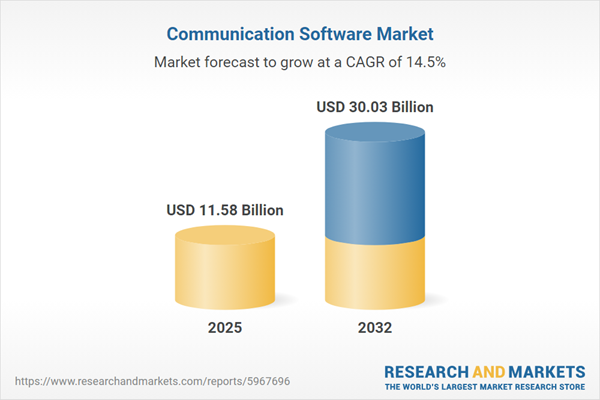Speak directly to the analyst to clarify any post sales queries you may have.
The communication software market is rapidly evolving as businesses prioritize digital collaboration tools to enhance productivity and maintain competitive agility. Driven by shifting work models and emergent technologies, communication platforms have become indispensable for modern organizations seeking operational resilience and improved stakeholder engagement.
Market Snapshot: Communication Software Market Growth and Dynamics
The communication software market grew from USD 10.17 billion in 2024 to USD 11.58 billion in 2025, with a projected CAGR of 14.49%, expected to reach USD 30.03 billion by 2032. Expansion is fueled by the integration of cloud, AI, and enhanced security technologies, responding to organizations’ pressing needs for scalable, secure platforms amid hybrid and remote work transformations.
Scope & Comprehensive Segmentation
This market research covers a multi-dimensional view of the communication software landscape, including solution types, pricing options, deployment modes, organization size, application use cases, key verticals, and regional perspectives.
- Communication Types: Text-based (email, instant messaging, SMS), unified communication, video (telepresence, video conferencing, webinars), and voice communication (PSTN, VoIP).
- Pricing Models: Freemium, one-time license, pay-per-use, subscription-based.
- Deployment Modes: Cloud-based, on-premise.
- Organization Size: Large enterprises, small & medium enterprises.
- Application Areas: Customer communication, file and document collaboration, internal communication, project management integration, real-time communication, team collaboration.
- Verticals: Banking and financial services, insurance, education, energy and utilities, government, healthcare, IT and telecom, manufacturing, media and entertainment, retail and eCommerce, transportation and logistics.
- Regions Covered: Americas (including North America and Latin America), Europe, Middle East & Africa, and Asia-Pacific.
- Representative Vendors: 8x8, Agile CRM, Asana, Atlassian, Axero Holdings, Cisco, Connecteam, Everbridge, Google, GoTo Technologies, Happeo, HubEngage, LumApps, Meta Platforms, Microsoft, Mphasis, Oracle, PeopleOne, ProofHub, RingCentral, Salesforce, SAP, Siemens, Simpplr, Staffbase, Vonage, Zoho, Zoom Communications, among others.
Key Takeaways for Senior Decision-Makers
- Hybrid and remote work realities are reshaping enterprise collaboration requirements, prompting an accelerated shift to cloud-native unified communication platforms and modular solutions.
- AI-powered analytics and automation are enabling actionable insights, improving user engagement, and supporting more personalized customer experiences across key verticals.
- Heightened security standards and regulatory compliance are driving demand for advanced encryption, zero-trust architectures, and adaptive licensing models to ensure business continuity.
- Mobile enablement and real-time accessibility are influencing purchasing decisions, with user experience and seamless integration becoming vital competitive differentiators.
- Vendor partnerships with hyperscale cloud and cybersecurity providers are essential to delivering scalable, resilient, and compliant offerings suitable for diverse organizational needs.
Tariff Impact and Market Adaptation
Recent US tariff policies have increased costs for imported hardware, prompting businesses to shift toward cloud subscription models and flexible licensing approaches. Vendors are strengthening alliances with domestic data centers and accelerating investments in local manufacturing and alternative networking solutions to mitigate disruption risks.
Methodology & Data Sources
The report applies a rigorous multi-phase research methodology, combining primary executive interviews with secondary analysis from authoritative industry sources. Insights are validated through real-world case studies, segmentation mapping, and competitive benchmarking to ensure reliability and relevance for decision-makers.
Why This Report Matters for B2B Leaders
- Enables targeted investment strategies by illuminating crucial trends in the communication software market, including technology shifts and regulatory drivers.
- Equips leadership with actionable recommendations to navigate evolving collaboration environments, mitigate compliance risk, and power digital transformation.
Conclusion
The market for communication software is poised to support organizations through rapid changes in collaboration, technology, and regulation. Senior leaders who act on these insights will position their enterprises for sustained growth and future readiness.
Additional Product Information:
- Purchase of this report includes 1 year online access with quarterly updates.
- This report can be updated on request. Please contact our Customer Experience team using the Ask a Question widget on our website.
Table of Contents
3. Executive Summary
4. Market Overview
7. Cumulative Impact of Artificial Intelligence 2025
Companies Mentioned
The companies profiled in this Communication Software market report include:- 8x8, Inc.
- Agile CRM
- Asana, Inc.
- Atlassian
- Axero Holdings LLC
- Cisco Systems, Inc.
- Connecteam
- Everbridge, Inc.
- Google LLC
- GoTo Technologies USA, LLC
- Happeo Oy
- HubEngage, Inc.
- LumApps SAS
- Meta Platforms, Inc.
- Microsoft Corporation
- Mphasis Limited
- Oracle Corporation
- PeopleOne
- ProofHub
- RingCentral, Inc.
- Salesforce, Inc.
- SAP SE
- Siemens AG
- Simpplr Inc.
- Staffbase GmbH
- Vonage Holdings Corp.
- Zoho Corporation Pvt. Ltd.
- Zoom Communications, Inc.
Table Information
| Report Attribute | Details |
|---|---|
| No. of Pages | 199 |
| Published | November 2025 |
| Forecast Period | 2025 - 2032 |
| Estimated Market Value ( USD | $ 11.58 Billion |
| Forecasted Market Value ( USD | $ 30.03 Billion |
| Compound Annual Growth Rate | 14.4% |
| Regions Covered | Global |
| No. of Companies Mentioned | 29 |









